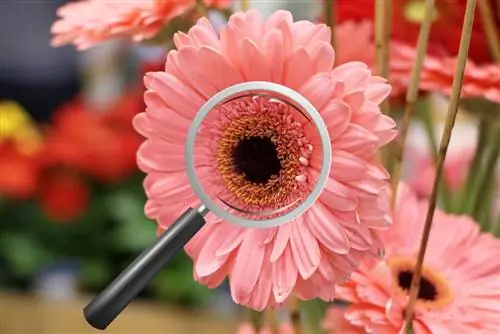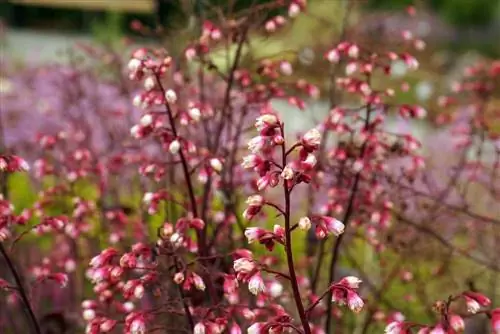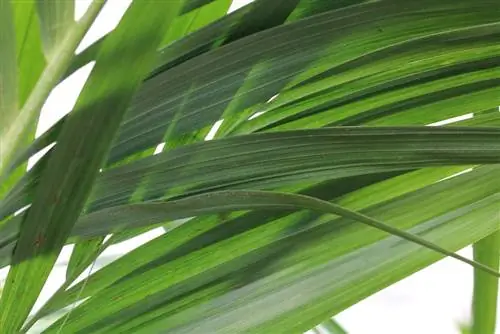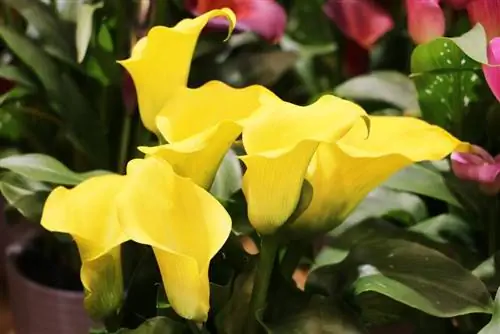- Author admin [email protected].
- Public 2023-12-17 03:39.
- Last modified 2025-06-01 06:48.
Did you fall madly in love with a magnificent houseplant at first sight? Then you should be familiar with the name so that you can welcome the floral beauty at home and care for it in an exemplary manner. Various methods of plant identification will guide you to a well-founded result. It's easy, but debatable, to do it with images. Reliable results are provided by identification books with a gradual decision-making process that requires solid gardening knowledge. This guide explains the best tried and tested approaches. This is how you can successfully identify flowering and green plants for living spaces.
Methods for beginners
If you are just starting out as an indoor gardener, the visual identification features of the plant in question offer a good starting point. Photos, pictures and drawings make a verbal description of flower and leaf shapes unnecessary. Furthermore, you are not forced to distinguish between woody or herbaceous growth and similar botanical characteristics. For beginners in indoor gardening, three approaches that work with and without electronic support have proven to be effective.
Plant detection via app
Gardeners without a green thumb but with a smartphone can recognize plants using an app. The practical mini-programs are installed quickly and are usually free. The image section with flowers, leaves or fruits is selected directly from the application. Press the shutter button and send the image to the server. The answer is promptly beamed at you on the screen, often accompanied by an informative short text or Wikipedia article, as with the free app “iPlant”. The only disadvantage is that you cannot check the search result.
The plant recognition app “Pl@ntNet”, which is also free, offers further options. Here you can select in advance whether you want to identify the houseplant you are looking for based on its flower, leaf or fruit. The app was developed by a team from several French research institutions and is also available in German.
The majority of German-language plant recognition apps are still under construction. Some providers have integrated a community function. You can use this to upload photos that cannot be assigned. Maybe another user is already cultivating the plant in their home and can reveal the name.
Determine online
Plant recognition via app is still in its infancy. If you want reliable results, look at online portals for identifying houseplants using pictures or already known properties. We have put popular providers through their paces to introduce you to the following selection:

plantopedia.de/plantdetermination
Plantopedia is on the rise among portals for plant identification with an uncomplicated search tool. A total of 9 criteria with more than 50 sub-points will guide you unerringly to the coveted plant name. In addition to classic aspects such as flower color or flowering time, you can choose based on location, soil type, pH value and lime tolerance. Behind the site is a young, innovative gardening magazine that leaves no question unanswered about plants and care. It's worth keeping an eye on Plantopedia's plant identification, as almost 400 species are already recorded.
- Advantage: broad search criteria
- Disadvantage: To date no distinction between bedding and house plants
plantdetermination.info/roomplants
A simple and clear page design invites you to search and browse. You choose from five flower colors, multi-colored flowers or all colors. You can also select by number of petals. For example, if you are looking for the name of a houseplant with red or pink, six-petaled flowers, large photos will appear with the matching species from A, like amaryllis, to Z, like zephyr flower. The portal has set up its own categories for orchid lovers and cacti fans. If you can't provide any further information about flowers, you're still not lost. On the “Leaf Identification” subpage it is possible to identify perennials and trees by their foliage, either in the young stage or in autumn.
- Advantage: numerous pictures in the best quality
- Disadvantage: Botanical plant names without German translation
plantfriends.com/roomplants
If the indoor gardener already knows some of the criteria, he or she will find them on this page when identifying plants. An encyclopedia presents a variety of domestic and tropical houseplants in alphabetical order. Each encyclopedia entry has a picture and provides information about the level of difficulty in care, possible uses and location conditions. In addition, the portal offers a selection of indoor palms, orchids, succulents, cacti, bulbous plants, gesnerias, flowering and easy-care houseplants.
- Advantage: every houseplant with picture, botanical and German name
- Disadvantage: very time consuming without knowledge of certain properties
plantdetermination.de
The large portal of botany takes third place in this selection because a specific search for houseplants is not possible. The site compensates for this shortcoming with differentiated criteria. You have the choice to search by features, images or vegetative properties without flowering. The last option in particular provides valuable assistance in clearly identifying a non-flowering plant. If the portal reaches its limits, like-minded people are available to offer advice and support in the integrated forum.
- Advantage: intuitive search with the ability to skip certain categories
- Disadvantage: Few houseplants so far
plantdetektiv.de
The specialist publisher Ulmer comes with a recommended tool if you want to define a houseplant. A total of 5 categories are offered: plant type, flower color, flowering time, flower height and plant height. All hits are presented with a picture, German and botanical name. If you click on a result, further information about room beauty opens. Origin and growth characteristics are supplemented with useful information on location, use, propagation and care. Recommended varieties round off the meaningful result.
- Advantage: Easy to use the search mask, lots of helpful information
- Disadvantage: very small number of houseplants
iowe.de
The Institute of Economic Ecology has set itself the task of supporting beginners and advanced users in plant identification. The simple search starts with the flower color and allows the option unknown. If you are familiar with the height, you can continue with this information in the second step. Finally, you have the option of additionally narrowing down the results based on the flowering period. If you can provide information about all categories, you will receive a manageable hit list.
- Advantages: uncomplicated search, sometimes over 1,000 hits
- Disadvantages: not all plants with photos, no distinction between outdoor and indoor plants
Tip:
Are you just interested in knowing whether an unknown houseplant is a flowering or green plant? Then the bud shape provides more information. Leaf and shoot buds can usually be recognized by their narrow, tapered shape. Flower buds, on the other hand, are revealed by their round to spherical shape. Furthermore, flower buds are usually significantly larger than buds that turn into leaves or shoots.
Identification in print media
For good reason, historical reference works and recognized knowledge portals on the Internet, such as Wikipedia, use photos and drawings alike in articles describing plants. In contrast to photos, hand-made illustrations can show or highlight important details. If the identification process using an app or online photos still leaves you in doubt about the actual type of houseplant, an illustration will shed light on it. No botanical knowledge is required for identification, just a good eye. We looked around the book market and filtered out the following richly illustrated titles for identifying houseplants:
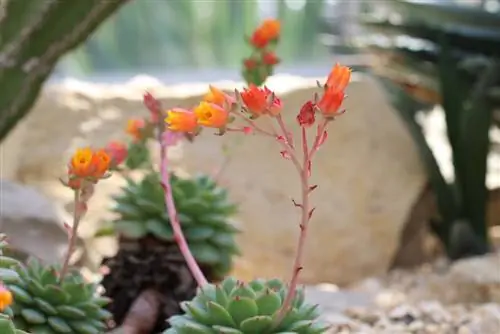
1200 garden and house plants
One of the most meaningful standard works comes from the pen of the experienced garden and landscape architect, plant collector and author Martin Haberer. A total of 1,200 plant portraits provide a quick overview of traditional and modern plants for living rooms, winter gardens, beds and balconies. Important botanical identifying features, detailed drawings and 1220 color photos pave the way to the plant name you are looking for. Valuable information on location requirements and care round off the popular reference work for home gardeners.
- ISBN 978-3-8001-0363-8
- Price for the hardcover book: from 19.90 euros
Picture Atlas of potted plants for rooms and balconies
On 361 pages, numerous profiles and tables will help you find the unknown plant name. The 4th revised edition also includes 696 color photographs and 23 drawings to aid the identification process.
- Authors: Moritz Bürki, Marianne Fuchs
- ISBN 978-3-8001
- Price for the hardcover book: from 39, 90 euros
What is that? The 120 most important houseplants
This small picture atlas is perfect for getting started with identifying houseplants. On 120 cards, even inexperienced hobby gardeners can quickly identify the most popular plants for windowsills and winter gardens. Meaningful profiles with clear illustrations and understandable texts also enable houseplants to be cared for better.
- Authors: Kaspar Heißel, Martin Haberer
- ISBN 978-3-8186-0348-9
- Price for book and 120 cards in a folding box: from 12 euros
Determination key - method for advanced users
Anyone who has acquired solid basic knowledge as an indoor gardener uses a scientific method to search for the name of a houseplant. A determination book with an integrated determination key accompanies you step by step through the decision-making process. The primary requirements are botanical knowledge of plant shape and flower structure as well as the horticultural competence to identify relevant distinguishing criteria. It begins with general distinguishing criteria, such as growth with herbaceous or woody shoots. In the style of a yes/no decision, all questions branch out as long as there are at least two possible answers. The so-called dichotomous bowl ends where no choice is possible and the result is fixed. Simply put, this branching structure is a decision tree with a reliable result.
The following example illustrates (incompletely) how you can reliably identify flowering and green plants using an identification key:
1. Tree or bush? (go to 2)
-, Herbaceous growth? (go to 3)
2. Leaves opposite? (go to 4)
-, leaves alternate? (go to 5)
3. Water plant? (go to 7)
-, land plant? (go to 8)
4. Parasites on trees? (continue with strap flowers)
-, not a parasite? (go to 6)
The initially simple questions gradually delve deeper into botanical details, which require in-depth specialist knowledge to answer. For example, one of the last questions before identifying daisies is: Does the pappus of at least the middle flower consist of a ring of hair?
The standard work for plant identification is the legendary Schmeil-Fitschen, which has now appeared in its 93rd edition under the title “The Flora of Germany and the Neighboring Countries”. The three major identification classics “Brohmer (Fauna in Germany) - Fitschen (woody flora) - Schmeil-Fitschen” were published in a slipcase by Quelle & Meyer Verlag in January 2018.
Everything failed - what now?
If none of the above (or other) sites bring the desired results, try tackling the problem in a simpler way. A Google search with “houseplant” followed by the most noticeable feature sometimes helps. The image search is suitable for comparisons with the real plant and is therefore quite helpful. If that doesn't produce any results either, find a garden/houseplant forum you trust and post pictures of your plant - write down the most important characteristics and hope that someone can help you.

